15 Backyard Games Kids Played Before Suburbs Had Fences

Growing up in the 1980s meant living in a world where the neighborhood itself was your playground, and property lines were more suggestion than rule. Back then, fences were more for decoration than division, and no one thought twice about kids darting across lawns, cutting through backyards, or hopping over hedges in search of their next adventure.
We’d start with just a couple of friends on the block, but by the time we reached the end of the street, our little brigade had doubled—sometimes tripled—ready for an epic game of capture the flag, a bike race, or a round of flashlight tag as the sun dipped low.
Those games weren’t just ways to kill time. They were the training grounds for life. We learned how to compromise, lead, follow, and bounce back from scraped knees and bruised egos. No smartphones, no schedules—just the magic of spontaneity and the unspoken rule that you’d better be home by dinner.
Looking back, I realize those wide-open suburbs gave us something rare: a sense of freedom, community, and imagination that truly knew no boundaries. In those fence-free neighborhoods, childhood wasn’t just lived—it was shared, and every day held the promise of a new adventure.
1. Kick the Can
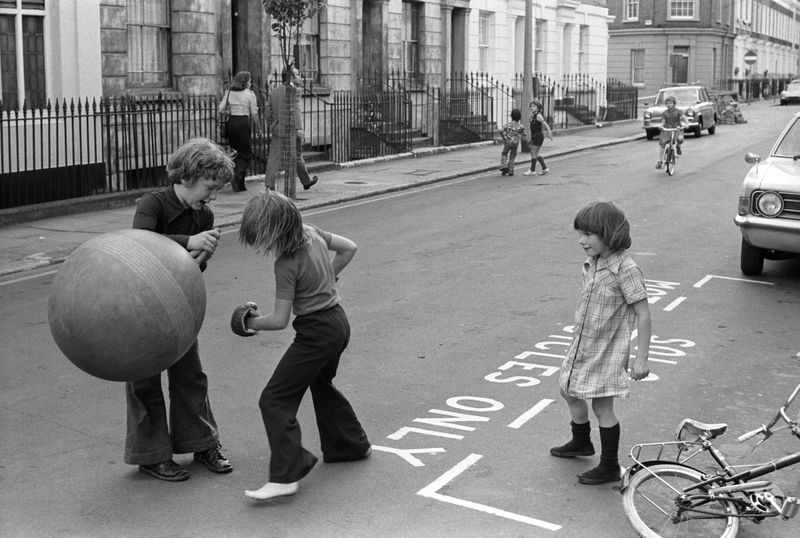
Nothing beat the heart-pounding thrill of Kick the Can on summer evenings! An empty coffee can placed in the center of someone’s driveway transformed our quiet street into an arena of strategic warfare.
I remember crouching behind Mrs. Henderson’s hydrangea bushes, watching our neighbor Tommy (who was ‘It’) guarding the can with hawk-like intensity. The real magic happened when someone brave—usually my friend Jessica—would create a diversion, allowing another kid to sprint from hiding and boot that can halfway down the street. The ensuing chaos of freed prisoners scrambling for new hiding spots while Tommy desperately chased after the can was pure childhood bliss.
Our version included a special rule: if you kicked the can three times in one game, you earned the title ‘Liberation Legend’ until the next gathering. I held that title exactly once and bragged about it for an entire month!
2. Red Rover
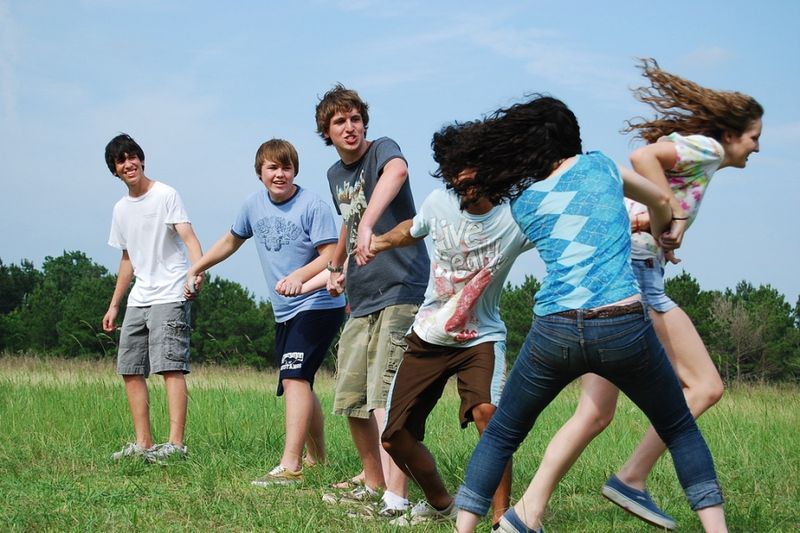
Red Rover turned ordinary lawns into battlegrounds of strength and strategy. My skinny arms still remember the burn of holding on for dear life when the neighborhood bruiser came charging through our human chain.
We’d form two lines facing each other, maybe fifteen feet apart, linking hands so tightly our knuckles would turn white. The classic call—’Red Rover, Red Rover, send Jimmy right over!’—would ring out, and Jimmy would barrel toward what he thought was the weakest link in our chain. Sometimes our line would hold firm, capturing Jimmy into our ranks. Other times, he’d break through with triumphant glee, selecting one of our teammates to join his side.
The game taught us to read people—who was strong, who would give way easily, who would stubbornly hang on despite being dragged through the grass. By summer’s end, grass stains decorated our knees, and we’d learned more about teamwork than any school project could teach.
3. Hide and Seek
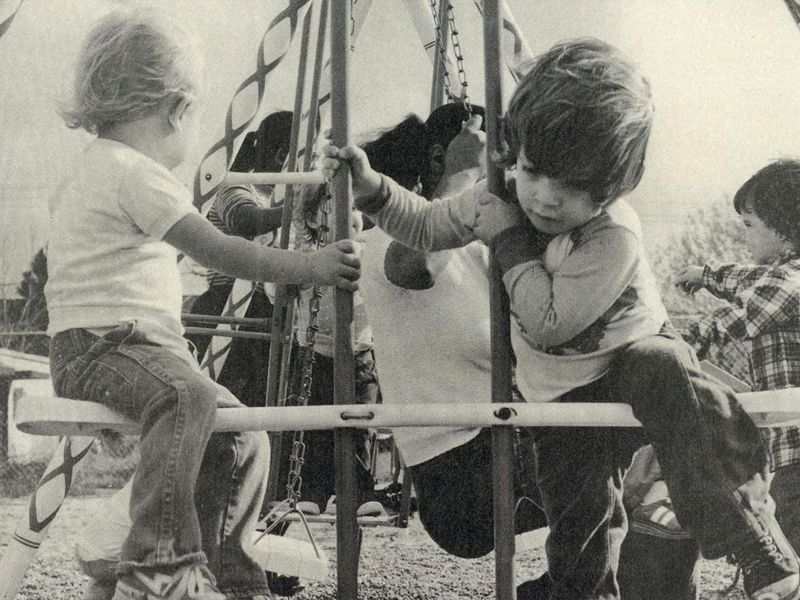
The ancient art of Hide and Seek reached its pinnacle in our fence-free neighborhood paradise. With no boundaries between yards, the hiding possibilities seemed infinite—Mrs. Wilson’s azalea bushes, the Thompsons’ boat tarp, or the legendary crawlspace under the Jacobsons’ deck.
My go-to spot was perched in the lower branches of our maple tree, where the leaves provided perfect camouflage. From this vantage point, I’d watch the seeker wandering aimlessly, sometimes passing directly beneath me without a clue. The real pros among us mastered the art of circular movement, always staying opposite the seeker’s position.
Our neighborhood version included a home base—usually a porch or tree—that hidden players could race to if they spotted an opportunity. Nothing matched the rush of sprinting toward base with the seeker hot on your heels, your friends cheering wildly as you dove to safety with inches to spare.
4. Capture the Flag
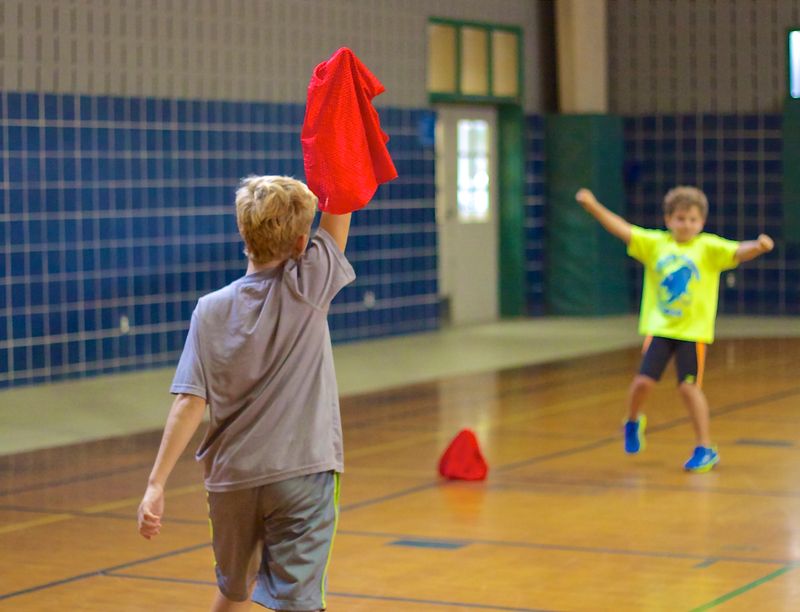
Capture the Flag reigned supreme as the ultimate test of neighborhood warfare tactics. Our version sprawled across six adjacent backyards, with natural landmarks serving as territory boundaries—the Millers’ oak tree to the Petersons’ garden shed marked the dividing line.
Each team would hide their flag (usually an old t-shirt tied to a stick) somewhere visible but not obvious within their territory. Our team once secured a legendary victory by placing our flag atop Mr. Donovan’s tool shed, hiding in plain sight where no one thought to look up. Strategy sessions before games were intense affairs, with kids mapping out zones, assigning roles, and planning elaborate feints to distract the opposing team’s defenders.
Getting tagged and sent to ‘jail’ wasn’t the end—you’d wait desperately for a teammate to risk everything on a jailbreak run. Those heroes who successfully retrieved the enemy flag and returned it to home territory achieved neighborhood fame lasting at least until the next weekend’s rematch.
5. Flashlight Tag

As twilight descended on our street, the ordinary games of daylight gave way to the electric thrill of Flashlight Tag. Parents would call out ‘be home when the streetlights come on,’ which we interpreted as permission to roam until the very last possible moment.
Armed with Dad’s heavy metal flashlight (the one he kept for power outages), ‘It’ would count to fifty while the rest of us scattered into the gathering darkness. Unlike daytime games, Flashlight Tag created a delicious tension—the beam sweeping across lawns could catch your movement at any moment. The key was to freeze instantly when you sensed the light approaching, becoming one with the landscape.
My friend Danny once remained so perfectly still behind a birdbath that ‘It’ shined the light directly on him but didn’t recognize the human shape. The rest of us nearly gave away our positions by suppressing giggles! The game naturally ended when enough moms started calling names into the darkness, signaling it was time for everyone to reluctantly head home.
6. Freeze Tag

Freeze Tag turned ordinary kids into living statues scattered across a canvas of connected backyards. I remember the summer of ’85 when my best friend Marcus developed what we called ‘statue poses’—ridiculous frozen positions that made it nearly impossible for other players to tag you without bursting into laughter.
The beauty of the game lay in its simplicity—one touch from ‘It’ and you’d freeze mid-motion, one leg possibly raised for a step, arms outstretched in failed escape. You’d remain there, a human sculpture, eyes darting desperately to catch the attention of unfrozen friends who could release you with a touch. Strategic players would unfreeze the fastest runners first, creating instant chaos for ‘It’ to manage.
Our neighborhood added a special rule where if you remained frozen for five full minutes, you could perform a dramatic ‘statue melt’ and rejoin the game. This led to heated debates about time-keeping accuracy that sometimes lasted longer than the game itself!
7. Four Square
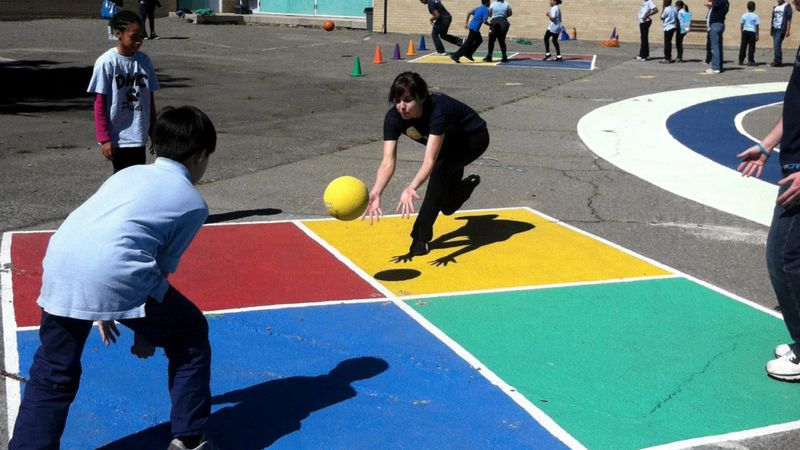
The Peterson family’s extra-wide driveway became hallowed ground when someone broke out the chalk for Four Square. Squares were meticulously measured—not with rulers, mind you, but with Kenny Peterson’s sneakers, size 11 even though he was only twelve.
Each square had a rank: the coveted A square (or ‘King’) down to the lowly D square where newcomers started. I spent most of one summer clawing my way up from D only to be ruthlessly bounced back down by Jessica Miller’s wicked ‘around the world’ serve. The rules evolved through passionate neighborhood negotiations—cherry bombs (hard downward hits) were eventually banned after little Timmy from two doors down went home crying when one nearly broke his fingers.
Four Square thrived in the absence of fences because when the ball inevitably escaped the court, the chase would continue unimpeded across multiple yards. Parents knew what the chalk squares meant and would casually kick errant balls back toward the game while watering their gardens or retrieving mail.
8. Sharks and Minnows

The Johnson family’s massive backyard—a luxurious double lot—transformed into a perilous ocean for Sharks and Minnows. My knobby knees still remember the grass stains from desperate dives to avoid being tagged.
We’d designate one kid as the Shark (usually the fastest runner) who stood in the middle of the yard. The rest of us, the Minnows, would line up on one side, nervously shifting weight from foot to foot. When the Shark yelled ‘SWIM!’, we’d make a mad dash for the opposite side while the Shark attempted to tag as many Minnows as possible. Each tagged Minnow became a new Shark for the next round, creating an increasingly terrifying gauntlet.
Our version included ‘seaweed’—areas where you had to slow down and wave your arms like underwater plants. Cutting through the Thompsons’ yard to avoid the growing Shark population was considered fair game, though Mrs. Thompson occasionally joined as a ‘surprise Shark’ if she was gardening nearby, causing screams of delighted terror from all of us.
9. Jump Rope
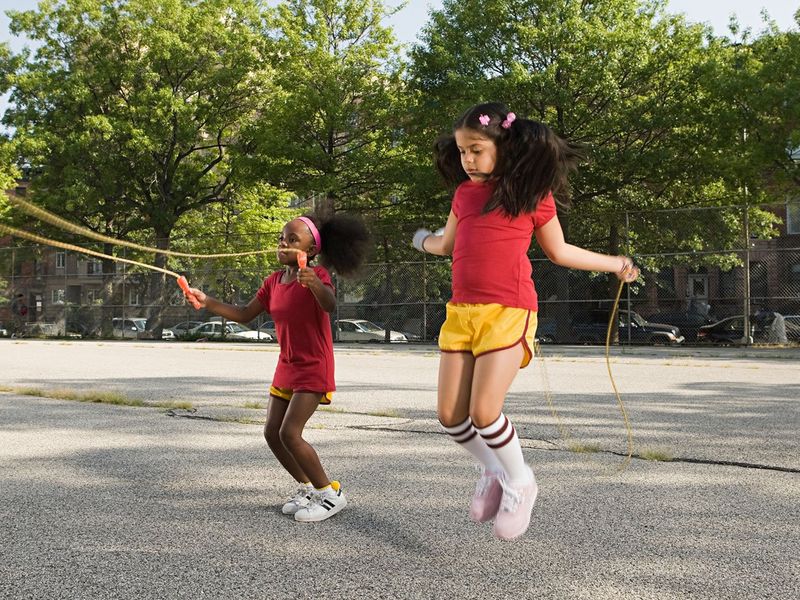
Jump rope wasn’t just a game—it was a neighborhood spectacle that would migrate from driveway to driveway as kids joined in. Two turners would whip that rope (often borrowed from someone’s dad’s garage) in perfect rhythm while chanters kept time with rhymes passed down through generations of schoolyards.
‘Cinderella, dressed in yella, went upstairs to kiss a fella…’ The rhymes were endless, and learning them all was a childhood achievement as important as riding a bike. Double Dutch separated the amateurs from the legends—I never mastered it despite a summer of skinned knees and determination. My friend Alicia, however, could jump double dutch while simultaneously chewing gum and carrying on a conversation about last night’s episode of ‘The Facts of Life.’
The beauty of fence-free suburbs meant jump rope sessions could attract participants from blocks away, drawn by the distinctive whipping sound and children’s voices chanting in unison. Some afternoons would see fifteen kids taking turns, the session ending only when the rope finally frayed or someone was called home for dinner.
10. Kickball
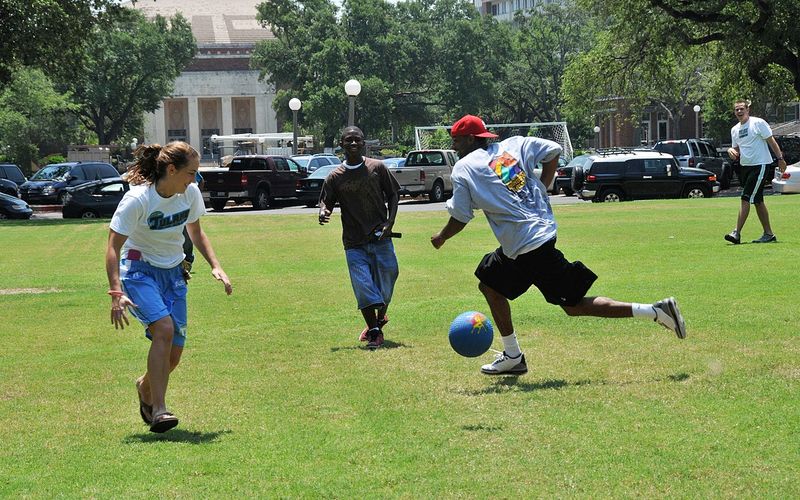
The crack of a rubber ball against a sneaker would echo through our neighborhood, signaling that kickball was underway. Unlike organized sports with their uniforms and adult referees, our kickball games materialized organically—someone would produce a ball, bases would be designated (often using discarded sweatshirts or someone’s bike), and teams would form through the ancient ritual of captains picking players.
Home plate was always the storm drain at the end of Maple Street, with first base being the Williams’ maple tree, second base the fire hydrant, and third base a particularly flat rock in the Hendersons’ front yard. The outfield extended across multiple properties, with ground rules establishing that Mrs. Abernathy’s prized rose bushes were strictly off-limits—any ball landing there was an automatic out.
Arguments about whether someone was safe or out could last longer than the innings themselves, resolved through complex neighborhood diplomacy or occasionally by invoking the sacred ‘do-over’ rule. Games would stretch across entire afternoons, with players rotating in and out as kids arrived or were called home for chores.
11. Manhunt
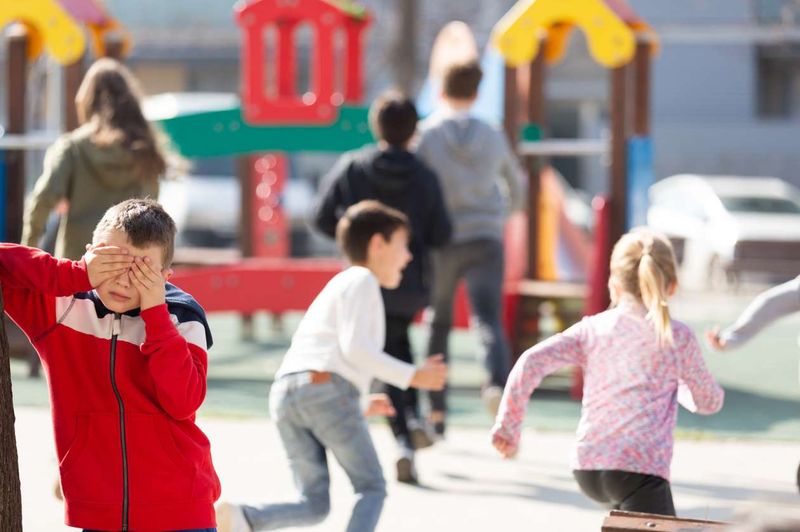
As dusk settled over our neighborhood, Manhunt emerged as the ultimate test of stealth and strategy. It was Hide and Seek evolved to its final form—a high-stakes game spanning multiple yards where the hunters worked as a team to track down those in hiding.
The boundaries were ambitious—usually four or five connected blocks—with certain areas designated as off-limits (like Old Man Wilson’s yard, who never quite understood our games). My favorite hiding spot was wedged between the Johnsons’ shed and their compost bin; the earthy smell masked my presence even when hunters passed within inches. The game’s tension built as more hiders were discovered and joined the hunting party, their triumphant shouts echoing through the neighborhood as another player was found.
Our version included a safe zone—usually someone’s front porch light—where discovered players could make a mad dash for immunity if they spotted it before being tagged. The game would continue until every last hider was found or parents started calling kids home, whichever came first.
12. Double Dutch
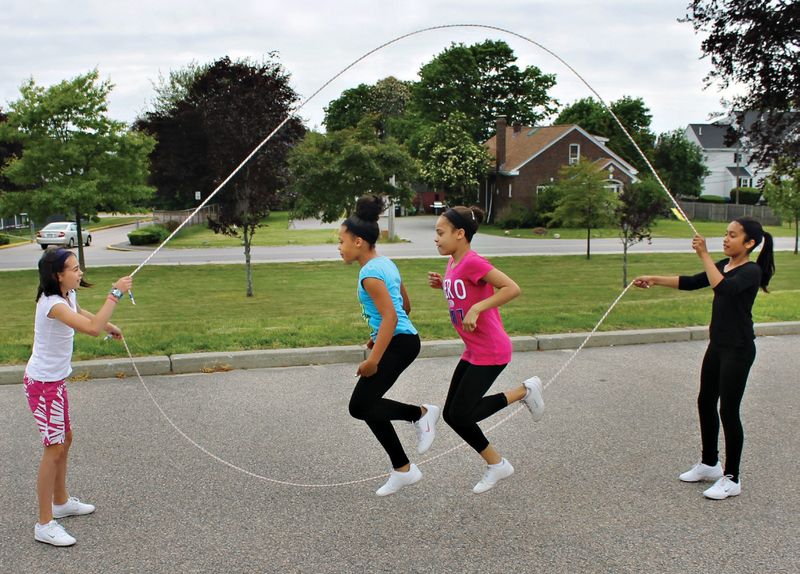
The rhythmic slap-slap-slap of two jump ropes hitting pavement announced that Double Dutch was in session! The Rodriguez sisters from the corner house were the undisputed Double Dutch queens, their wrists rotating with hypnotic precision as they turned those ropes for anyone brave enough to attempt entry.
Jumping Double Dutch wasn’t just about timing—it was performance art. The basic jump was merely your entry ticket; true masters would add kicks, turns, and hand claps while neighborhood spectators provided both audience and chorus for the accompanying rhymes. ‘Ice cream soda, cherry on top, how many boyfriends have you got?’ The counter would continue until you tripped on a rope, each successful jump adding to your neighborhood status.
My crowning achievement came during the summer of ’84 when I managed 37 consecutive jumps while performing our neighborhood’s signature move—the ‘Twist and Shout’—which involved a 180-degree turn on every fourth jump. The respect earned from that feat carried me through the entire school year that followed!
13. Ghost in the Graveyard

When the sun dipped below the horizon but parents hadn’t yet called us home, Ghost in the Graveyard transformed our familiar neighborhood into a twilight realm of suspense. One player—the Ghost—would hide while the rest gathered around a designated home base, usually the tallest tree in someone’s front yard.
We’d chant in unison, our voices rising with each repetition: ‘One o’clock, two o’clock, three o’clock, rock… twelve o’clock, midnight, hope I see a ghost tonight!’ Then we’d scatter with flashlights, hearts pounding as we searched shadowy yards for the hidden Ghost. The first player to spot the Ghost would yell ‘Ghost in the graveyard!’ triggering a frantic stampede back to home base as the Ghost gave chase.
Being caught by the Ghost meant joining them in the next round, creating multiple Ghosts lurking in the growing darkness. The game brilliantly balanced fear and fun—scary enough to quicken your pulse but playful enough that even the youngest kids would join in, clutching their plastic flashlights with determined bravery.
14. Mother May I?

Mother May I? turned ordinary summer afternoons into exercises in childhood diplomacy and dramatic acting. Standing in a line across the Wilsons’ sprawling front yard, we’d take turns appealing to ‘Mother’—usually the bossiest kid on the block who relished the temporary power.
The game’s beauty lay in its creative requests: ‘Mother, may I take five bunny hops?’ or ‘Mother, may I take three giant steps?’ If granted permission with the sacred ‘Yes, you may,’ you’d execute your move with theatrical flair. Forget to ask ‘Mother May I?’ and you’d be sent back to the starting line amid groans and giggles. The strategic players mastered the art of modest requests that wouldn’t trigger Mother’s denial, while risk-takers would swing for the fences with audacious moves.
Our neighborhood version included special moves named after local landmarks—’Thompson tree steps’ (stretching your arms up like branches) or ‘Peterson puddle jumps’ (leaping over imaginary water). The game perfectly filled those late afternoon hours when it was too early for dinner but too late to start anything elaborate.
15. TV Tag
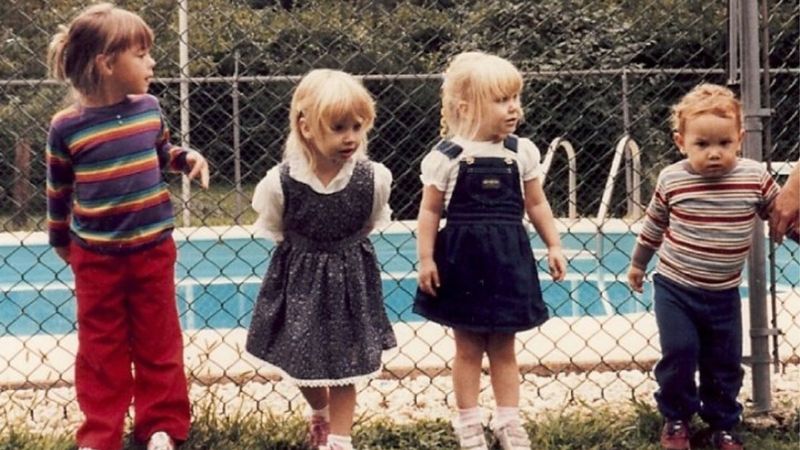
TV Tag injected pop culture into our neighborhood chase games with hilarious results. The standard rules of tag applied with one brilliant twist—you could become temporarily ‘safe’ by quickly shouting out a TV show name and freezing in a pose that represented that show.
I still remember Joey Simmons yelling ‘The A-Team!’ before striking a Mr. T pose, gold-painted macaroni necklaces jangling as he grimaced fiercely. The pose had to be held until another player was tagged, creating yard landscapes dotted with human statues frozen in increasingly ridiculous positions. The unwritten rule was that no TV show could be used twice in the same game, leading to desperate deep cuts when popular shows were claimed—somebody once yelled ‘Captain Kangaroo!’ when cornered against the Hendersons’ garage.
Arguments about whether poses accurately represented shows were frequent and passionate. ‘That doesn’t look anything like The Dukes of Hazzard!’ might be countered with ‘I’m sliding across the hood of the General Lee!’ The game naturally evolved with our TV viewing habits, with new shows entering rotation whenever the fall lineup premiered.
